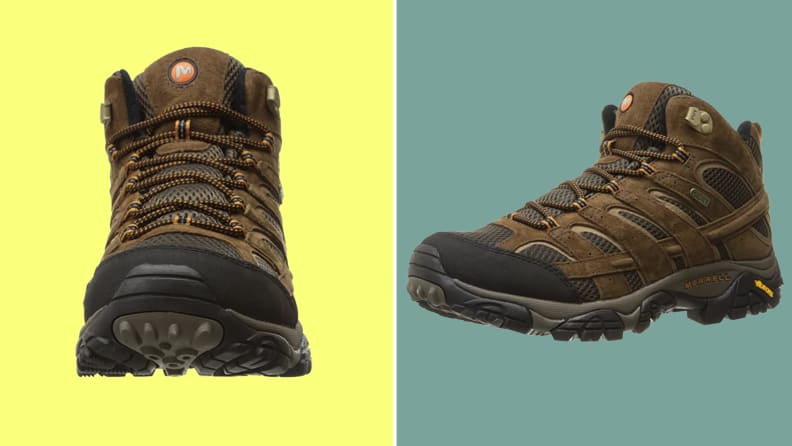Products are chosen independently by our editors. Purchases made through our links may earn us a commission.
This story was updated for the New Jersey and New York earthquakes.
Today, April 5, New York City, New Jersey, and the surrounding area experienced a rare 4.8 magnitude earthquake, the largest in years. The seismic activity happened about five miles east of Lebanon, New Jersey. While earthquakes in the region are rare, New York is near the Ramapo fault line, making seismic activity possible.
We spoke to Margaret Vinci, the manager of the Office of Earthquake Programs at the Caltech Seismological Laboratory in Southern California and the USGS lab, which is the home of the Southern portion of the California Integrated Seismic Network, about how to prepare for an earthquake.
Vinci emphasizes it is good practice to familiarize yourself with earthquake safety no matter where you live. “Don’t think it’s not going to happen to you,” she says. History shows us it just might.
So, do you know how to prepare for an earthquake? Consider this.
Best practices for earthquake safety
Immediate action
When you get an early warning alert or you feel shaking, you want to drop, cover, and hold on. Make sure that you are protecting your head.
“Drop to the ground immediately, before the shaking starts and throws you off your feet,” says Vinci. “Crawl and get underneath something to protect you from falling objects, hold on to whatever you’re under, because if it’s a table or it’s a chair it’s going to walk away from you.”
If this isn’t possible, try to get next to an interior wall, not an exterior one.
“In an earthquake, the roof goes up, and the walls fall out,” she explains. “Get down on the ground, and make yourself as small as possible. Put your hand over your head and neck to protect those places. Find an area where you’re not near glass or doors.”
Then, she says, stay there until the shaking stops.
Contrary to what you may think you know, Vince cautions, “Do not go into a door frame.”
She explains that in older times, when buildings collapsed, often the door frame was the last part standing. However, buildings are no longer constructed this way. Taking shelter in a door frame could expose you to rolling debris like fire extinguishers.
When leaving your home, look around and up to ensure that you aren’t near a chimney that could fall. Falling debris and heavy objects from rooftops are a common danger in quakes and aftershocks, even after the shaking stops.
Lastly, do not flick on and off your light fixtures, says Vinci. Gas leaks are a real concern after earthquakes. Visit Earthquake Country to familiarize yourself with what to do in the hours and days after a disaster.
How to prepare for an earthquake
Practicing drop cover and running earthquake drills from time to time is essential. If you live in an area that’s prone to earthquakes, it’s important to prep your home, too.
“Anything over six feet tall needs to be secured to the wall, so that it doesn’t injure people or block an exit,” she says. “Small objects should be secured with putty.”
Vinci says that if a 7.8-magnitude earthquake were to happen in Southern California, having an emergency plan would be crucial.
Be self-sufficient, but be ready to help a neighbor in need.
There is a program called Map Your Neighborhood, which teaches people how to work together to be self-sufficient. After a large earthquake, emergency responders may not be able to reach them quickly, from days to a week.
Vinci also recommends considering CERT training or Community Emergency Response Teams, which is FEMA-sponsored emergency training typically provided through local fire departments.
Gather these emergency supplies if you live in an earthquake-prone area
1. Emergency whistle

A whistle can be a great substitute for a yell or scream if needed.
Vinci says, “Always have a whistle. You can blow a whistle a lot longer than you can yell for help.”
She recommends keeping one whistle with you everywhere you go. Then spread more emergency whistles around your home, in drawers, or wherever is handy.
A whistle is a straightforward method for letting emergency responders know where you are during a search and rescue effort. Make sure to buy one that is easily storable in a convenient spot for quick access.
2. Water

A back-up water supply is a no-brainer when it comes to emergency necessities.
Not keeping enough water is one of the fastest ways to die in the days after a disaster. Vinci recommends stocking your home with one gallon of water per person, per day, with a supply large enough to last seven to 10 days. In addition, keep three days worth of water in your emergency grab-and-go pack. Make sure to include additional water for pets.
Large, five-gallon jugs are great for your home supply because you can refill them. A water filter such as a LifeStraw Family portable filter could also come in handy.
3. Stocked emergency backpack

A sturdy, heavy-duty backpack will be a handy addition if you need to leave in a hurry.
Vinci recommends keeping one or more fully stocked grab-and-go bags. Leave these grab-and-go bags at home, at work, and in your car. One bag should remain under your bed, where you can easily access it for overnight emergencies.
For the under-the-bed bag, Vinci recommends that you tie it to the underside of the bed. This way, you can quickly grab it without worrying if it has shot across the room.
A school backpack could work, while a more rugged hiking pack will give you more space for your supply kit.
Fill the grab-and-go emergency preparedness kits with necessities and disaster supplies needed for a few days. Include eyeglasses, medicines, escape tools, cash, contact information, car keys, extra batteries, matches, emergency food supplies, water, and a change of clothes.
4. Hard-soled shoes

If you're trek to safety is a lengthy one, invest in some quality hard-soled shoes, like these from Merrell.
Having hard-soled shoes that you can put on during an earthquake is essential, says Vinci. Keep these sturdy shoes in or tied onto your under-the-bed bag. You don’t want to jump out of bed and walk on broken glass.
Choose a rugged pair of hard-soled shoes that will protect your feet as you move around a dangerous environment.
5. Flashlight

When earthquakes occur, there's also the possibility of a blackout. Just in case, keep headlights or a flashlight on hand.
A flashlight ensures that you won’t trip over objects. Vinci recommends keeping your flashlight or a headlamp with your hard-soled shoes in your survival pack under your bed.
Headlamps are the choice when you want more dexterity, as they provide light and keep your hands free.
6. Crowbar

Be sure to keep your crowbar compact enough to fit in your go-bag.
A good crowbar can help you navigate out of compromised spaces. Vinci says, “I keep a crowbar so that I can open doors that are jammed shut.”
A small crowbar could make all the difference if you get trapped in a disaster. Choose one that fits comfortably in your grab-and-go bag.
7. First aid kit

In the event that you're injured as a result of the earthquake and you need to shelter in place, a first aid kid can stop bleeding or wrap minor sprains.
A first aid kit is a critical item to keep in your grab-and-go bag. This could mean the difference between life and death for you or your family.
Your first aid kit should include gauze, wrap-around bandages, and small stick-on bandages. Antiseptics, antibiotic ointment, and burn supplies are also great to have.
8. A hard hat

Falling debris is inevitable if the earthquake is severe enough.
Since covering your head is essential during and after an earthquake, Vinci recommends keeping a hard hat with your grab-and-go disaster bag. A bike helmet will work well if you don’t want to spring for a classic OSHA hard hat.
Hard hats are important to wear in earthquake zones because aftershocks are common. Heavy objects and rubble can remain loose even after the shaking has stopped.
9. A bivvy bag or emergency blanket

The SOL Emergency Blanket is compact enough to fit in the zipper compartment of any backpack.
To protect from hypothermia, a bivvy bag like the SOL Emergency Bivvy is a great thing to have. The SOL Emergency Blanket is another good option. Either could make the difference on a cold night.
The SOL bivvy is both wind-proof and waterproof. It features a reflective interior coating that's designed to reflect up to 90% of your body heat back to you.
10. Emergency food supply

Be sure to pack foods that are simple, don't require much heat or preparation.
Peanut butter is a cheap, non-perishable food. You can leave it in your grab-and-go pack or your stash of emergency food supplies.
Amy’s Chili or other non-BPA-lined canned soups also make great picks; they can safely be heated over a campfire right in their can. Portion canned food that is high-calorie and high-protein split between your grab-and-go bags. This offers nutritious warm meals in a disaster situation, wherever you end up.
11. A map

Don't rely solely on your phone for travel–use a traditional map like in the old pioneer days.
A good road atlas is important. In a major disaster, there’s the possibility that cell phone service and the internet will go down.
Keep a road atlas like the National Geographic atlas in your bags, as well as a local map. Familiarize yourself with your city's map before a disaster happens so that you’ll be prepared.
12. A multi-tool

Leatherman offers you a multi-use tool that does it all.
The Red Cross suggests that you invest in a multi-tool. One like the Leatherman comes with lots of useful blades and tools, including a fire starter.
A multi-tool prepares you for all sorts of situations, from cooking to handling small wounds to fixing technology. You can even use it to start a campfire to heat your food or keep warm.
13. Hand crank radio

The Midland ER310 is an absolute must if you need to call for emergency rescue services, charge vital medical equipment, or need listen to important information on the radio.
Another Red Cross suggestion is a NOAA hand crank radio like the Midland ER310. This radio can keep you informed of the latest weather-related happenings and keep your phone charged, too.
When your power goes down, a hand crank radio can still update you on conditions in your area. Most come with a flashlight built right in.
What parts of the U.S. are most prone to earthquakes?
Vinci makes it clear that parts of the U.S. have significant seismic risk. When we ask Vinci what parts of the U.S. are most in danger of earthquakes, she mentions California and the West Coast, as well as the central U.S.' New Madrid fault.
The New Madrid fault touches a few states, like Missouri, Tennessee, and Arkansas with the most territory. “This [region] had a rupture in the 1800s, where the Mississippi River ran backward.”
More resources for earthquake safety preparedness
Many people have other specific needs that may not be on this list. Research natural disaster risks in your area to determine what you need.
Vinci recommends Earthquake Country Alliance as a tool for earthquake preparedness. “Earthquake Country Alliance was created to bring the Red Cross, FEMA, Los Angeles County, and the cities together to have common and consistent messaging.”
The Red Cross also has a good guide on earthquake preparedness.


